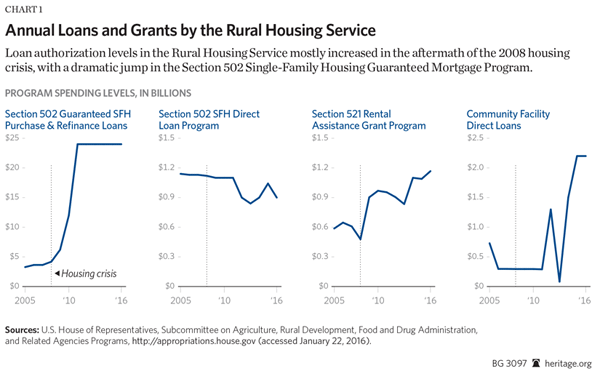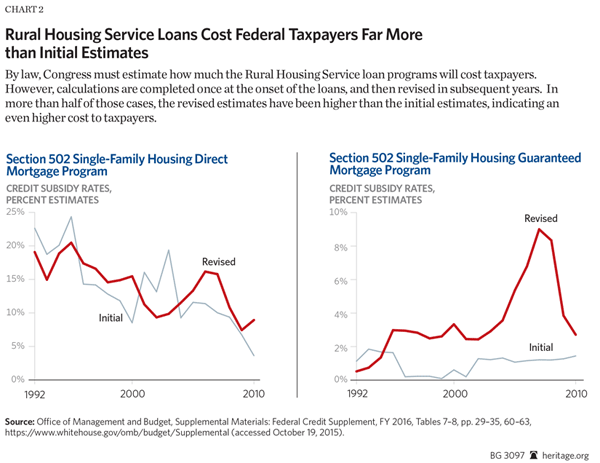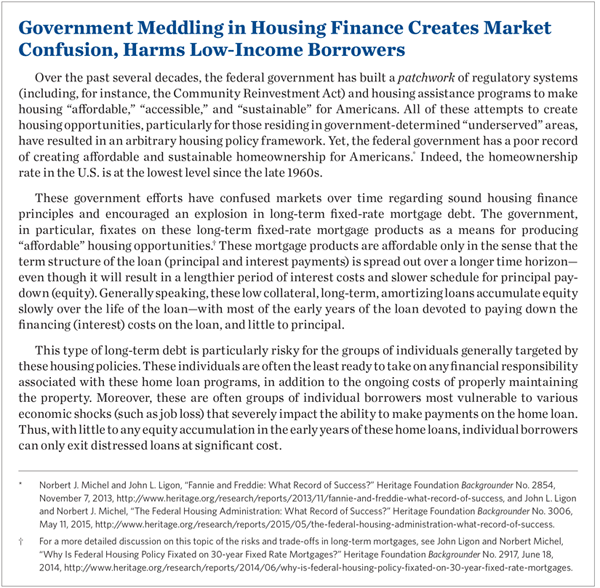The Rural Housing Service (RHS) of the U.S. Department of Agriculture (USDA) is an unnecessary artifact—part of the post–New Deal vision of federal government housing policy. At the RHS’s inception in 1949, the agency was primarily focused on providing rural-development support to farmers and laborers. Today, however, the RHS specifically targets “underserved” rural areas through means-tested housing assistance. The agency focuses the majority of its activity in the single-family-housing (SFH) guaranteed-mortgage program.
The RHS, one of many federal agencies with an “affordable” housing mission, operates with a high level of overall credit risk. In fact, the default rate in the agency’s SFH guarantee programs is at least double that of a comparable single-family loan-guarantee program at the Federal Housing Administration. The agency’s home loan programs and those across the federal agencies tend to put higher-risk, financially vulnerable individuals into debt. Yet, all of the government intervention has failed to increase the overall rate of homeownership in the U.S., which is at the lowest level since the late 1960s.
Moreover, current advocates of the RHS and federally administered rural-development assistance programs argue that a private market for mortgage credit would not exist without the government guarantees. Audit research on the RHS, though, indicates that a significant share of the households benefitting from the taxpayer-subsidized mortgage credit do not even reside in rural zip codes. In many instances, eligible mortgage lenders also offer borrowers other loan options alongside the RHS guaranteed loans. In all likelihood, the agency crowds out real private-sector credit without government guarantees, especially those credit-guarantee programs that specifically charge below-market interest rates.
Thus, Congress should restore a free market for mortgage credit in these rural areas by eliminating the direct-loan, loan-guarantee, and grant-assistance programs managed by the RHS. The mortgage credit guaranteed by the RHS should originate in a free market without government intervention. Eliminating these subsidies will restore incentives for both borrowers and lenders to properly judge credit risk in these rural area markets, and over time, ensure that private real estate and property capital is allocated to the most productive uses, creating the conditions for real wealth creation and economic opportunity in these rural area markets.
What Is the Rural Housing Service?
The RHS is one of four agencies of the U.S. Department of Agriculture with a mission to serve designated rural areas through various economic development programs. These rural areas, however, particularly those that the RHS purports to serve, have entirely changed from the agrarian-focused rural economies of the mid-20th century.[1] In 1949, the agency focused on credit assistance to farm owners and farm laborers.[2] Beginning in the 1960s, the RHS provided loan and grant assistance for farm properties, as well as loans for the purchase of and repairs on non-farm properties.
The RHS began to dramatically shift the focus of its overall loan portfolio in the early 1990s from the Section 502 Single-Family Housing Direct Mortgage program to the Section 502 SFH Guaranteed Mortgage program. The SFH Guaranteed Mortgage program is less labor intensive than the SFH Direct Mortgage program, giving the RHS an additional means to expand its operations to a broader population of borrowers.[3] As a result, the SFH Direct Mortgage program has consistently declined as a share of the agency’s loan portfolio since it peaked in the mid-1970s.[4] Indeed, over the past decade, from fiscal year (FY) 2005 to FY 2016, total loan authorization levels have remained roughly constant over the past decade at approximately $1.1 billion annually.
To accomodate this shift, Congress has expanded the Section 502 SFH Guaranteed Mortgage program, which is by far the largest program managed by the RHS today with a total annual loan authorization of $24 billion in FY 2016. After the housing crisis of 2008, Congress doubled the total loan authorization levels from FY 2009 to FY 2010 ($6.2 billion to $12 billion), and then again, from FY 2010 to FY 2011 ($12 billion to $24 billion). Since FY 2011, the SFH Guaranteed Mortgage program has remained at this annual total loan authorization level of $24 billion.
The Rural Housing Service agency additionally manages several other loan and grant programs focused on both multi-family housing (rental) assistance and community facility development. These programs have also experienced growth in annual total authorization levels since the 2008 housing crisis. The Section 521 Rental Assistance Grant program has nearly doubled in size from $587 million to $1.2 billion between FY 2005 and FY 2016, and community facility direct loans have increased from $729 million to $2.2 billion over the same period. (See Chart 1.) USDA Inspector General audit reviews of the program indicate that there are significant issues with improper rental payment procedures and income documentation errors throughout the system.[5]
This Backgrounder focuses primarily on the two flagship Section 502 single-family housing mortgage programs.
Whom Does the Rural Housing Service Serve?
Currently, the RHS is almost entirely focused on providing means-tested housing assistance (for ownership and rental) to non-farm households in RHS-designated rural markets. The RHS administers two programs targeted at single-family homeownership assistance in eligible rural markets: (1) the Section 502 Single-Family Housing Direct Mortgage Program, and (2) the Section 502 Single-Family Housing Guaranteed Mortgage program. In the SFH Direct Mortgage program, the RHS acts as the loan and property inspector, servicer, and guarantor; in the SFH Guaranteed Mortgage program, the agency principally relies on lenders to serve as property inspector and home loan servicer. Thus, the RHS absorbs the cost of failed loans in the Section 502 SFH Direct Mortgage program as well as up to 90 percent of the loan-loss claims on failed loans in the Section 502 SFH Guaranteed Mortgage program.[6]
The RHS administers the two Section 502 housing loan programs following two key criteria. First, the Rural Housing Service determines eligible rural markets, and eligible loans must reside within these designated areas. Second, the RHS determines income limits (ceilings) for the various means-tested housing programs. The RHS targets the Section 502 SFH Direct Mortgage program to very-low-income and low-income borrowers. The agency sets the eligibility threshold for these two groups of borrowers at less than 50 percent of area median family income for very-low-income borrowers, and between 50 percent and 80 percent of area median family income for the low-income borrowers.[7] The Section 502 SFH Guaranteed Mortgage program income threshold is set between 80 percent and 115 percent of median county income for the SFH Guaranteed Mortgage program.
Despite the overall intention, it is not altogether clear that the RHS is targeting a unique group of “underserved” rural borrowers. In assigning the “underserved” areas, the RHS, like other federal agencies with rural-development missions, has a high degree of flexibility in determining whether an area is “rural in character.”[8] As a result, there is a significant amount of carryover into non-rural areas—and, hence, overlap with other federal housing programs, primarily housing assistance programs managed by the Department of Housing and Urban Development.[9] Indeed, audit research[10] of the RHS indicates that more than half the agency’s portfolio provides mortgage credit to areas located in metropolitan zip codes, and approximately 75 percent of SFH Guaranteed Mortgage loans were given to borrowers living in areas within 25 miles of an RHS-ineligible area.
How Do the RHS Programs Perform?
The Section 502 SFH Guaranteed Mortgage program, by far the largest program managed by the agency, operates with a lower level of credit risk than the Section 502 SFH Direct Mortgage program, even though the default rate for the program is double that of the flagship SFH Mortgage guarantee program operated by the Federal Housing Administration.[11] The reduced credit risk in this SFH Guaranteed Mortgage program (compared to the SFH Direct Mortgage program) is largely a result of higher levels of borrower income, including almost 20 percent of borrowers with incomes exceeding the program’s income ceiling. Moreover, eligible lenders indicate that they make these rural-development home loans available alongside other mortgage options for borrowers.[12] Based on these accounts, there is likely some selection bias for these programs among borrowers with higher incomes (and assets).
These portfolio characteristics, among others, effectively leave the eligibility determination in the hands of the eligible private lenders, and based on audit studies of the lending practices, the judgment of loan eligibility (and loan take-up by borrowers) is subjective. It also undermines any rationale for this guaranteed government credit, especially when these are individuals with adequate means (both in income and assets) and eligible private lenders indicate that they are making available other mortgage options, alongside the rural development loans.[13] After all, if given the choice for a lower financing (interest) cost option it can be a strategic decision for borrowers to take up this type of loan.
The RHS, on the other hand, makes little attempt to properly adjust for the financial risk of borrowers in its separate Section 502 SFH Direct Mortgage program. The Section 502 SFH Direct Mortgage program functions with a significantly higher level of portfolio credit risk. In fact, the default rate in this program is almost five times the rate of default in a comparable loan insurance program managed by the Federal Housing Administration.[14] Thus, the underwriting practice in this direct mortgage program by design charges below-market interest rates to borrowers with low and very low income levels, while requiring no down-payment, limited income history, and mediocre (at best) credit history, and perversely puts higher-risk, financially vulnerable individuals into home loans that they may have significant trouble servicing over the loan term.[15] (See Text Box.)
How Much Do the SFH Loan Programs Cost the Taxpayer?
The RHS, like other government-backed credit agencies, garners a significant credit-funding advantage over its private-sector competitors, namely that it can issue and guarantee credit (debt) to private borrowers at below-market interest rates. The credit guarantees not only divert private capital from more productive uses, they also represent a taxpayer-financed subsidy. Since the Federal Credit Reform Act of 1990, Congress is required to estimate the cost of these guarantee subsidy programs and the corresponding lifetime budgetary impact of federal direct-loan and loan-guarantee programs.[16] These budgetary cost estimates are completed during the initial year of the loans, and then in later years, show an updated (current) estimate cost of the annual cohort of loans.
The majority of the RHS loan guarantee programs show a net lifetime budgetary cost for each cohort of loans dating back to FY 1992. In fact, except for the past few fiscal years, each annual cohort of loans for the two Section 502 SFH mortgage programs shows a net lifetime budgetary cost with a higher revised cost estimate than that of the initial estimate.[17] According to official estimates, for FY 1992 to FY 2010, the net lifetime subsidy cost is $278 million for the SFH Guaranteed Mortgage program, and $115 million for the SFH Direct Mortgage program.[18]
Time to Shut Down the Rural Housing Service
The Rural Housing Service direct-loan and loan-guarantee programs crowd out private-sector credit in rural markets. Eliminating the agency’s loan-guarantee activity would induce more real private-sector credit (credit not backed by the government) into these markets over time. Thus, the RHS should be shut down. In this process, the U.S. Department of Agriculture will have to wind down the existing loan portfolio of approximately $120 billion in single-family and multi-family housing loans.[19] Further, Congress will need to cease all annual loans and grant-authorization appropriations.
Specifically, Congress should:[20]
- Eliminate all loan-guarantee programs (single-family, multi-family, and community-facility loan programs). This should specifically preclude any transfer of loan-guarantee authorization to a different federal government agency—within USDA or any other federal department.
- Eliminate all direct-loan programs (single-family, multi-family, and community-facility loan programs). This should specifically preclude any transfer of direct-loan authorization to a different federal government agency—within the USDA or any other federal department.
- Eliminate the direct-rental-assistance grant programs. This should specifically preclude any transfer of rental-assistance grant funding to a different federal government agency—within the USDA or any other federal department.
Conclusion
The purpose and need for the Rural Housing Service, a rural development agency of the U.S. Department of Agriculture, is unclear. Unlike the rural and farm populations that the agency served at its inception in 1949, the RHS today provides the largest portion of its credit-guarantee assistance to non-farm households, a significant share of which do not even reside in rural zip codes. Moreover, eligible lenders benefit from many of the features of the current system, particularly the fact that they receive low-cost mortgage debt subsidized by the federal taxpayer with limited downside risk in the event of loan failure. In all likelihood, the agency crowds out real private-sector credit without government guarantees, especially those credit guarantee programs that specifically charge below-market interest rates. Congress should restore a free-market housing-finance system by shutting down the RHS and eliminating its direct-loan, loan-guarantee, and grant-assistance programs.
—John L. Ligon is Senior Policy Analyst and Research Manager in the Center for Data Analysis, of the Institute for Economic Freedom and Opportunity, at The Heritage Foundation. He thanks Astrid Gonzalez, former member of the Heritage Foundation Young Leaders Program, for her research assistance.





